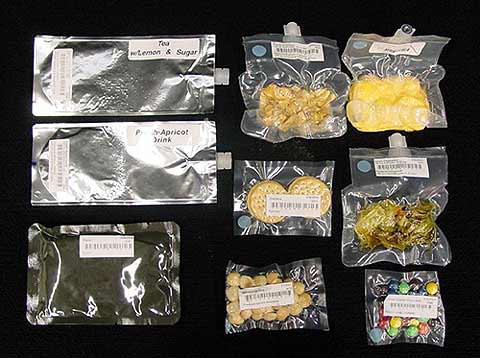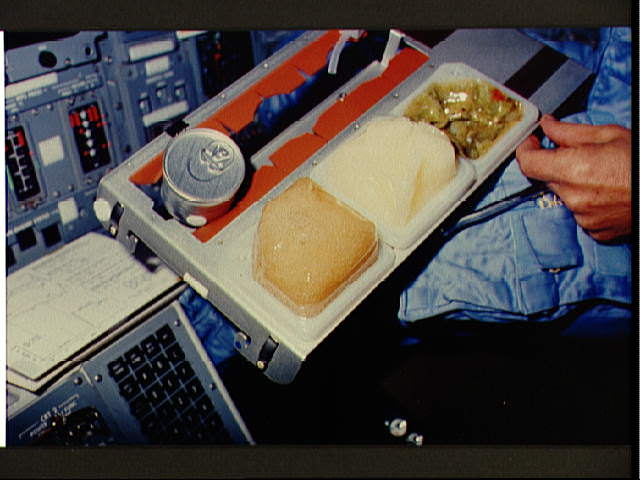[/caption]
NASA has made tremendous progress during the past fifty years with regards to food science. Gone are the days of nutrients in toothpaste style tubes and it’s safe to assume NASA astronauts haven’t had to drink Tang in decades.
At a recent meeting of the American Chemical Society, Maya R. Cooper, senior research scientist at NASA’s Space Food Systems Laboratory discussed how feeding astronauts will be one of the most difficult issues to resolve before launching a manned mission to Mars.
Despite all the progress NASA has made, what challenges still need to be overcome to feed the crew of a manned mission to Mars?
When we plan a camping trip, not much thought is given to what will be eaten during a weekend, a week, or even a month’s time. Modern food science has given us products that are safe to eat after even weeks, and in some cases months. It is very easy to go to the store and load up on delicious and nutritious food, with the expectation that said food will be relatively safe to eat with minor concerns for safety.
Manned spaceflight however, isn’t your average camping trip. Even during a one to two week mission, NASA astronauts can’t just open a refrigerator and make themselves a cold-cut sandwich. Food scientists at NASA must specially prepare meals for astronauts in order to ensure said meals are safe to consume during the mission, not only for the crew, but for their habitat as well. The average can or bottle of pop wouldn’t provide the same level of safety and satisfaction for a crew in space as it would for a person on Earth. Food crumbs can clog air filters or become lodged into sensitive equipment. Basically, what works well for a camping trip doesn’t always work for an ISS mission and what works for the ISS crew may not work for a multi-year mission to Mars.
In her talk, Cooper discussed some of the issues such as food safety that she and her team currently address. Some of the other issues discussed included food packaging, nutrition, weight, and of course variety.
Cooper cited that the current daily allocation of food for manned spaceflight crews is just under four pounds per day. Estimating a five-year trek to Mars would require over 7,000 pounds of food per crew person. “That’s a clear impediment to a lot of mission scenarios,” Cooper said. “We need new approaches. Right now, we are looking at the possibility of implementing a bioregenerative system that would involve growing crops in space and possibly shipping some bulk commodities to a Mars habitat as well. This scenario involves much more food processing and meal preparation than the current food system developed for the space shuttles and the International Space Station.”

Image Credit: NASA/Johnson Space Flight Center
The idea behind bioregenerative systems is that plants could multi-task, not only providing food, but also removing carbon dioxide gas and releasing oxygen, just like plants on Earth. Plants that are prime candidates for a Mars mission would have very little inedible structure. So far, ten plants that require little room and grow with minimal work have been identified. A few of the ten ideal plants identified are lettuce, spinach, carrots, tomatoes, strawberries, some herbs and cabbage.
One other idea Cooper suggested for future manned missions to Mars, would be to ship food products ahead of time. Sending supplies in advance of a mission would result in less food and packaging flying onboard the manned spacecraft headed to Mars. There are a few questions regarding sending supplies in advance, namely what happens if a critical supply ship fails to reach Mars and whether current food preservation technology can guarantee adequate nutritional content for a mission to Mars.
“The NASA Advanced Food Technology project is currently working to address the issues of food variety, weight, volume, nutrition and trash disposal through research and external academic and commercial collaborations,” Cooper noted.
Source: American Chemical Society
Ray Sanders is a Sci-Fi geek, astronomer and space/science blogger. Visit his website Dear Astronomer and follow on Twitter (@DearAstronomer) or Google+ for more space musings.


But…
…I *like* Tang!
Tang is actually pretty good. No idea of the nutritional value though. Seems like a variation of Kool-Aid to me.
Nutrition facts and analysis of Tang.
Nutrition facts and analysis of Tang.
Thanks IVAN (I think?)
You can’t have Kool-Aid on the ISS. The Kool-Aid Man will bust a hole in the space station and it will lose atmosphere. Kool-Aid was invented first, but both it and Tang became popular in the 60’s and 70’s.
“Estimating a five-year trek to Mars would require over 7,000 pounds of food”
That’s 7,300 pounds of food. PER PERSON. Figure a four person crew … 29,200 pounds of food total.
The mass doubles when you consider the packaging as well. This is a serious impediment to sending astronauts to Mars. This 7000 lbs of food must also include about an equal amount of packaging, where all of this turns into an equal amount of mass in sewage and garbage. For a 6 manned crew this is 84,000 pounds of waste, or 42 tons. This is equal to the mass of the entire Apollo spacecraft plus LM This can be reduced if the mission timeline is shortened to 2 years; 9 months out, 6 months there and 9 months back with only about 17 tons.
We can’t just dump this stuff. Before reaching Mars it would be convenient if the waste were jettisoned before insertion into Martian orbit. However, this would contaminate Mars with Earth microbes. Once the spacecraft is in orbit if these wastes are parked in orbit this only delays the contamination, for just as satellite orbits decay, so too this would make it to the Martian surface. So then we have to “pack it out,” which costs.
LC
This is a serious impediment to sending astronauts to Mars.
Not really. It’s good to discuss and I would emphasize diversity, but it is very low on the problems list. You include both hydrated and dehydrated foods. You include bulk items that required a very low percentage of packaging. You definitely include meat if only jerky. 8kg per day per person gives you food, water and oxygen before any need for recycling. A three month supply required about one cubic meter per person. This isn’t a major issue.
An affordable Dragon mission will be able to put over ten mT safely on the mars surface for perhaps $200m in the next few years. We can oversupply a dozen researchers for very little once they have power to extract water and oxygen ISRU. We include lots of different seeds and perhaps some live earth soil as well to mix with the closest analogy we can produce on mars.
Fuel is your only real expense. Everything else is lost in the noise… including development costs if you don’t leave it up to the usual crowd.
A cubic meter for 3 months gets multiplied by 6 = # of crew and by 8 for the duration of a Mars mission. That is 48 cubic meters, or a cube volume equivalent to 3.6 meters on a side. You then need the storage capacity for this, the fuel to push it to Mars and back. Expand that by the additional requirements for other environmental needs, water, air and so forth.
The Space-X idea of sending astronauts in a small capsule is not going to work. Similarly, the recent proposal to get to an asteroid in capsules is also problematic. Even if you could somehow carry all these supplies, people packed into such small volumes for long periods of time simply go insane. This would be an experiment of sending a small prison cell-block into space. Prisoners become violent for these reasons. The crew would end up going insane with likely disastrous results. Such interplanetary missions will require an additional expense to provide the crew with enough housing space so they don’t go bonkers.
LC
Hibernation could be the answer. Animals can do it. There are emerging techniques for getting humans to do it too. At the moment, it is used to stabilize very injured people until they can be repaired, but we may try it on healty people too.
On the other hand, I don’t agree with the people who think it is cowardly not to send humans into space. Since Apollo, we have learned how to make computers that can do complex jobs. We are probably going to make them lighter and harder, which must mean they can go further than humans on the same technology. 7 tons is a lot of Mars Rover.
I was also thinking how much fun it must be to control a Mars Rover. You get to drive your buggy about an alien planet. You go home in the evening and you spend your weekends with your family. You come in to work again, and catch up where it has got to, and what it has done. Much more fun than sitting in a camper van for 6 months eating cereal bars and pasta bake, and drinking Tang and recycled body fluids though a straw. But, hey, maybe, that’s just me.
These video clips from NASA and ESA:
at the end illustrate a CME towards the end, which shows how it interacts with Earth’s magnetic field and the little magnetic domes on Mars. These are another problem, for they can be lethal.
The solution as I see it is to get a propulsion system with ISP > 1000s. Getting to Mars in a matter of weeks instead of many months is the best approach. Until then we will visit planets by virtual reality productions from space probes and robots.
LC
It could be even worse than that: “Storage area nine self-destructed last week and destroyed the ship’s entire supply of toilet paper.“
I’m not going to Mars if the food they are sending with me include “lettuce, spinach, carrots, tomatoes, strawberries, some herbs and cabbage.” Where’s the meat, protein and complex carbs? I feel hungry just thinking about getting sent to Mars in a tin can with only salad fixings to sustain me. Not that I’m a prime candidate or even in contention or have any possibility to become a candidate.
Figures. The wild varieties grow as pests down here.
What doesn’t figure is the idea of prepackaging foods. If you want a biosphere enclosure, you would have to support cooking.
Which variety, choice and time used, probably helps alleviate crew boredom. You can keep the prepackage for when crew are pressed for time and space, say close to descent and ascent.
Then you have an easier time pack supplies or plant depots, you can do what people always did: take flour and fat instead of bread (and recycle water), dry fruit and meat, and so on.
Water, flour, fat, salt, herbs, yeast, dried perishables – all that is covered. Remains eggs and milk. Would NASA support research into cell cultures for milk/yolk production? There could be social benefits as well. (Efficient production, if only an increased use in antibiotics … cells don’t have the splendid immune systems that multicellular organisms have.)
The pictures, and possibly discussion, of prepared food reminds of the early days of astronauts.
Astronauts revolted against being passive flight objects. Haven’t NASA learned anything since then?
Well, there are now over 30 varieties of Tang: http://tangtoday.com/list-of-tang-flavours/
The pictures, and possibly discussion, of prepared food reminds of the early days of astronauts.
Astronauts revolted against being passive flight objects. Haven’t NASA learned anything since then?